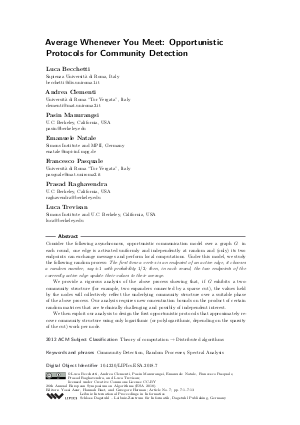Average Whenever You Meet: Opportunistic Protocols for Community Detection
Authors Luca Becchetti, Andrea Clementi, Pasin Manurangsi, Emanuele Natale, Francesco Pasquale, Prasad Raghavendra, Luca Trevisan
-
Part of:
Volume:
26th Annual European Symposium on Algorithms (ESA 2018)
Part of: Series: Leibniz International Proceedings in Informatics (LIPIcs)
Part of: Conference: European Symposium on Algorithms (ESA) - License:
 Creative Commons Attribution 3.0 Unported license
Creative Commons Attribution 3.0 Unported license
- Publication Date: 2018-08-14
File

PDF
LIPIcs.ESA.2018.7.pdf
- Filesize: 0.53 MB
- 13 pages
Document Identifiers
Related Versions
Subject Classification
ACM Subject Classification
- Theory of computation → Distributed algorithms
Keywords
- Community Detection
- Random Processes
- Spectral Analysis
Metrics
- Access Statistics
-
Total Accesses (updated on a weekly basis)
0PDF Downloads0Metadata Views
Abstract
Consider the following asynchronous, opportunistic communication model over a graph G: in each round, one edge is activated uniformly and independently at random and (only) its two endpoints can exchange messages and perform local computations. Under this model, we study the following random process: The first time a vertex is an endpoint of an active edge, it chooses a random number, say +/- 1 with probability 1/2; then, in each round, the two endpoints of the currently active edge update their values to their average. We provide a rigorous analysis of the above process showing that, if G exhibits a two-community structure (for example, two expanders connected by a sparse cut), the values held by the nodes will collectively reflect the underlying community structure over a suitable phase of the above process. Our analysis requires new concentration bounds on the product of certain random matrices that are technically challenging and possibly of independent interest. We then exploit our analysis to design the first opportunistic protocols that approximately recover community structure using only logarithmic (or polylogarithmic, depending on the sparsity of the cut) work per node.
Cite As Get BibTex
Luca Becchetti, Andrea Clementi, Pasin Manurangsi, Emanuele Natale, Francesco Pasquale, Prasad Raghavendra, and Luca Trevisan. Average Whenever You Meet: Opportunistic Protocols for Community Detection. In 26th Annual European Symposium on Algorithms (ESA 2018). Leibniz International Proceedings in Informatics (LIPIcs), Volume 112, pp. 7:1-7:13, Schloss Dagstuhl – Leibniz-Zentrum für Informatik (2018)
https://doi.org/10.4230/LIPIcs.ESA.2018.7
BibTex
@InProceedings{becchetti_et_al:LIPIcs.ESA.2018.7,
author = {Becchetti, Luca and Clementi, Andrea and Manurangsi, Pasin and Natale, Emanuele and Pasquale, Francesco and Raghavendra, Prasad and Trevisan, Luca},
title = {{Average Whenever You Meet: Opportunistic Protocols for Community Detection}},
booktitle = {26th Annual European Symposium on Algorithms (ESA 2018)},
pages = {7:1--7:13},
series = {Leibniz International Proceedings in Informatics (LIPIcs)},
ISBN = {978-3-95977-081-1},
ISSN = {1868-8969},
year = {2018},
volume = {112},
editor = {Azar, Yossi and Bast, Hannah and Herman, Grzegorz},
publisher = {Schloss Dagstuhl -- Leibniz-Zentrum f{\"u}r Informatik},
address = {Dagstuhl, Germany},
URL = {https://drops.dagstuhl.de/entities/document/10.4230/LIPIcs.ESA.2018.7},
URN = {urn:nbn:de:0030-drops-94705},
doi = {10.4230/LIPIcs.ESA.2018.7},
annote = {Keywords: Community Detection, Random Processes, Spectral Analysis}
}
Author Details
Funding
This material is based upon work supported by the National Science Foundation under Grants No. 1540685 and No. 1655215 and by the University of "Tor Vergata" under research programme "Mission: Sustainability" project ISIDE (grant no. E81I18000110005).
References
-
Dana Angluin, James Aspnes, David Eisenstat, and Eric Ruppert. The computational power of population protocols. Distributed Computing, 20(4):279-304, 2007.

- Luca Becchetti, Andrea Clementi, Emanuele Natale, Francesco Pasquale, Prasad Raghavendra, and Luca Trevisan. Average whenever you meet: Opportunistic protocols for community detection. CoRR, abs/1703.05045, 2017. URL: https://arxiv.org/abs/1703.05045.
- Luca Becchetti, Andrea Clementi, Emanuele Natale, Francesco Pasquale, and Luca Trevisan. Find your place: Simple distributed algorithms for community detection. In Proc. of the 28th Ann. ACM-SIAM Symp. on Discrete Algorithms (SODA'17), pages 940-959. SIAM, 2017. URL: http://dx.doi.org/10.1137/1.9781611974782.59.
- Stephen Boyd, Arpita Ghosh, Balaji Prabhakar, and Devavrat Shah. Randomized Gossip Algorithms. IEEE/ACM Transactions on Networking, 14:2508-2530, 2006. URL: http://dx.doi.org/10.1109/TIT.2006.874516.
-
Gerandy Brito, Ioana Dumitriu, Shirshendu Ganguly, Christopher Hoffman, and Linh V. Tran. Recovery and Rigidity in a Regular Stochastic Block Model. In Proc. of the ACM-SIAM Symposium on Discrete Algorithms (SODA), pages 371-390. ACM, 2015.

-
Aurelien Decelle, Florent Krzakala, Cristopher Moore, and Lenka Zdeborová. Asymptotic analysis of the stochastic block model for modular networks and its algorithmic applications. Physical Review E, 84(6):066106, 2011.

-
Paul W. Holland, Kathryn Blackmond Laskey, and Samuel Leinhardt. Stochastic blockmodels: First steps. Social networks, 5(2):109-137, 1983.

-
Laurent Massoulié. Community Detection Thresholds and the Weak Ramanujan Property. In Proc. of the ACM Symposium on Theory of Computing (STOC), pages 694-703. ACM, 2014.

-
Elchanan Mossel, Joe Neeman, and Allan Sly. A proof of the block model threshold conjecture. Combinatorica, pages 1-44, 2013.

-
Elchanan Mossel, Joe Neeman, and Allan Sly. Belief propagation, robust reconstruction and optimal recovery of block models. In Conference on Learning Theory, pages 356-370, 2014.

-
Elchanan Mossel, Joe Neeman, and Allan Sly. Reconstruction and estimation in the planted partition model. Probability Theory and Related Fields, 162(3-4):431-461, 2015.

- He Sun and Luca Zanetti. Distributed Graph Clustering and Sparsification. CoRR, abs/1711.01262, 2017. URL: http://arxiv.org/abs/1711.01262.
-
Matthew J. Williams, Roger M. Whitaker, and Stuart M. Allen. Decentralised detection of periodic encounter communities in opportunistic networks. Ad Hoc Networks, 10(8):1544-1556, 2012.

